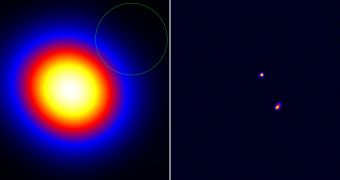European scientists and their collaborators are excited at the fact that the largest radio observatory in the world has just been inaugurated, and snapped its first images. The radio telescope array is nearly 1,000 kilometers wide, and features antennas at a variety of locations throughout Europe.
The International LOFAR (LOw Frequency ARray for radio astronomy) Telescope (ILT) has finally connected some of its research stations together, and managed to use these amazing capabilities to snap incredible views of distant cosmic structures.
While operating the observatory this month, investigators were able to collect an interesting view of an active black hole at the core of a distant galaxy. The object, called a quasar, is called 3C196.
Despite the huge distance between the structure and Earth, the telescope was able to snap an amazingly-clear picture at a high resolution. The entire array was created in such a manner that it can survey the entire sky at the lowest radio frequencies accessible from the surface.
The Chilbolton Observatory in Hampshire was also used as a component of LOFAR, and also as its westernmost station. “This is a very significant event for the LOFAR project and a great demonstration of what the UK is contributing,” explains expert Derek McKay-Bukowski.
He is also the STFC/SEPnet project manager at the LOFAR Chilbolton. “The new images are three times sharper than has been previously possible with LOFAR,” the official goes on to say.
“LOFAR works like a giant zoom lens – the more radio telescopes we add, and the further apart they are, the better the resolution and sensitivity,” McKay-Bukowski explains.
“This means we can see smaller and fainter objects in the sky which will help us to answer exciting questions about cosmology and astrophysics,” he adds further, quoted by Universe Today.
University of Southampton professor Rob Fender, the leader of LOFAR UK, says that the international facility managed to combine together readings from stations in the Netherlands, France, Germany and the United Kingdom.
The signals “have been successfully combined in the LOFAR BlueGene/P supercomputer in the Netherlands. The connection between the Chilbolton telescope and the supercomputer requires an Internet speed of 10 gigabits per second,” Fender explains.
“Getting that connection working without a hitch was a great feat requiring close collaboration between STFC, industry, universities around the country, and our international partners,” the expert concludes.

 14 DAY TRIAL //
14 DAY TRIAL //